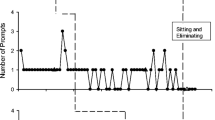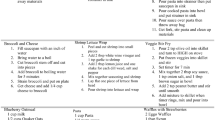Abstract
The current study evaluated the effects of an intervention package designed to teach independent toileting skills to two boys with autism spectrum disorder (ASD). A non-concurrent multiple baseline across participants design was employed to investigate the effects of video modeling that utilized animation to depict in-toilet voiding combined with prompting and reinforcement procedures. Results indicated that the intervention package was effective in teaching a sequence of behaviors necessary for successful and independent toileting (e.g., walking to the toilet, undressing, sitting on the toilet, dressing, and flushing) as well as in-toilet urination for both boys. Skills generalized to the school and were maintained over 3 to 4 months. The intervention may have also been responsible for teaching in-toilet defecation for one participant. Results are interpreted in relation to the differential contributions of video modeling and behavioral instructional strategies.



Similar content being viewed by others
Notes
Apple iPod/iPad is a registered trademark of the Apple Corporation, Cupertino California, www.apple.com
Proloquo2Go is a registered trademark of AssistiveWare B.V., Amsterdam the Netherlands, www.assistiveware.com
Final Cut Pro is a registered trademark of the Apple Corporation, Cupertino California, www.apple.com
Adobe Photoshop is a registered trademark of Adobe Systems Incorporated, San Jose California, www.adobe.com
References
Azrin, N. H., & Foxx, R. M. (1971). A rapid method of toilet training the institutionalized retarded. Journal of Applied Behavior Analysis, 4, 89–99.
Bainbridge, N., & Myles, B. S. (1999). The use of priming to introduce toilet training to a child with autism. Focus on Autism & Other Developmental Disabilities, 14, 106–109.
Baker, S. D., O'Reilly, M., & Lang, R. (2009). Review of video modeling with students with emotional and behavioral disorders. Education and Treatment of Children, 32, 403–420.
Cicero, F. R., & Pfadt, A. (2002). Investigation of a reinforcement-based toilet training procedure for children with autism. Research in Developmental Disabilities, 23, 319–331. doi:10.1016/S0891-4222(02)00136-1.
Darden-Brunson, F., Green, A., & Goldstein, H. (2008). Video-based instruction for children with autism. In J. K. Luiselli, D. C. Russo, W. P. Christian, & S. M. Wilczynki (Eds.), Effective practices for children with autism: Educational and behavioral support interventions that work (pp. 241–268). USA: Oxford University Press.
Drysdale, B., Lee, C. Y. Q., Anderson, A., & Moore, D. W. (2014). Using video modeling incorporating video modeling to teach toileting to two children with autism spectrum disorder. Journal of Developmental and Physical Disabilities. doi:10.1007/s10882-014-9405-1.
Green, V., Sigafoos, J., Didden, R., O’Reilly, M., Lancioni, G., Ollington, N., & Payne, D. (2008). Validity of a structured interview protocol for assessing children’s preferences. In P. Grotewell & Y. Burton (Eds.), Early childhood education: Issues and developments (pp. 87–103). New York: Nova.
Keen, D., Brannigan, K. L., & Cuskelly, M. (2007). Toilet training for children with autism: the effects of video modeling. Journal of Developmental and Physical Disabilities, 19, 291–303. doi:10.1007/s10882-007-9044-x.
Kennedy, C. (2005). Single-case designs for educational research. Boston: Pearson Education Inc.
Kroeger, K. A., & Sorensen-Burnworth, R. (2009). Toilet training individuals with autism and other developmental disabilities: a critical review. Research in Autism Spectrum Disorders, 3, 607–618. doi:10.1016/j.rasd.2009.01.005.
Lang, R., Shogren, K., Machalicek, W., Rispoli, M., O'Reilly, M. F., Regester, A., & Baker, S. (2009). Use of video self-modeling to teach classroom rules to two children with Asperger’s syndrome. Research in Autism Spectrum Disorders, 3, 483–488.
Lang, R., Ramdoss, S., Raulston, T., Carnett, A., Sigafoos, J., Didden, R., et al. (2014). Assistive technology for people with autism spectrum disorders. In G. E. Lancioni & N. N. Singh (Eds.), Assistive technology for people with diverse abilities (pp. 157–191). New York: Springer.
Lee, C. Y. Q., Anderson, A., & Moore, D. W. (2014). Using video modeling to toilet train a child with autism. Journal of Developmental and Physical Disabilities, 26, 123–134. doi:10.1007/s10882-013-9348-y.
Lindsay, C. J., Moore, D., Anderson, A., & Dillenburger, K. (2013). The role of imitation in video-based interventions for children with autism. Developmental Neurorehabilitation, 16, 283–289. doi:10.3109/17518423.2012.758185.
Lott, J. D., & Kroeger, K. A. (2004). Self-help skills in persons with mental retardation. In J. L. Matson, R. B. Laud, & M. L. Matson (Eds.), Behavior modification for persons with developmental disabilities: Treatment and supports (Vol. 2). New York: National Association for the Dually Diagnosed.
McCoy, K., & Hermansen, E. (2007). Video modeling for individuals with autism: a review of model types and effects. Education and Treatment of Children, 30, 183–213.
Murzynski, N. T., & Bourret, J. C. (2007). Combining video modeling and least-to-most prompting for establishing response chains. Behavioral Interventions, 22, 147–152. doi:10.1002/bin.224.
Nikopoulos, C. K., Canavan, C., & Nickpoulou-Smyrni, P. (2009). Generalized effects of video modeling on establishing instructional stimulus control in children with autism. Journal of Positive Behavior Interventions, 11, 198–207. doi:10.1177/1098300708325263.
Palechka, G., & MacDonald, R. (2010). A comparison of the acquisition of play skills using instructor-created video models and commercially available videos. Education and Treatment of Children, 33, 457–474. doi:10.1353/etc.0.0100.
Partington, J. W. (2010). The Assessment of Basic Language and Learning Skills Revised (The ABLLS-R). Pleasant Hill: Behavior Analysts, Inc.
Radstaake, M., Didden, R., Peters-Scheffers, N., Moore, D. W., Anderson, A., & Curfs, L. M. G. (2014). Toilet training in individuals with Angelman syndrome: a case series. Developmental Neurorehabilitation, 17, 243–250.
Rayner, C. (2014). Video-based intervention for children with autism: Towards improved assessment of pre-requisite imitation skills. Developmental Neurorehabilitation. doi:10.3109/17518423.2014.890959.
Rayner, C., Denholm, C., & Sigafoos, J. (2009). Video-based intervention for individuals with autism: key questions that remain unanswered. Research in Autism Spectrum Disorders, 3, 291–303. doi:10.1016/j.rasd.2008.09.001.
Reimers, T., Wacker, D., & Cooper, L. (1991). Evaluation of the acceptability of treatments for children’s behavioral difficulties. Child and Family Behavior Therapy, 13, 53–71.
Rinald, K., & Mirenda, P. (2012). Effectiveness of a modified rapid toilet training workshop for parents of children with developmental disabilities. Research in Developmental Disabilities, 33, 933–943.
Rosenberg, N. E., Schwartz, I. S., & Davis, C. A. (2010). Evaluating the utility of commercial videotapes for teaching hand washing to children with autism. Education and Treatment of Children, 33, 443–455. doi:10.1353/etc.0.0098.
Shukla-Mehta, S., Miller, T., & Callahan, K. J. (2009). Evaluating the effectiveness of video instruction on social and communication skills training for children with autism spectrum disorders: a review of the literature. Focus on Autism & Other Developmental Disabilities. doi:10.1177/1088357609352901.
Sparrow, S. S., Cicchetti, D., & Balla, D. A. (2005). Vineland Adaptive Behavior Scales (2nd ed.). Minneapolis, MN: Pearson Assessment, Inc.
Szyndler, J. (1996). Toileting problems in a group of children with autism. Child and Adolescent Mental Health, 1, 19–25.
Tereshko, L., MacDonald, R., & Ahearn, W. H. (2010). Strategies for teaching children with autism to imitate response chains using video modeling. Research in Autism Spectrum Disorders, 4, 479–489.
Vermandel, A., Van Kampen, M., Van Gorp, C., & Wyndaele, J. (2007). How to toilet train healthy children? A review of the literature. Neurology and Urodynamics, 27, 162–166. doi:10.1002/nau.20490.
Wang, H.-T., & Koyama, T. (2014). An analysis and review of the literature and a three-tier video modeling intervention model. Research in Autism Spectrum Disorders, 8, 746–758. doi:10.1016/j.rasd.2014.03.0101.
Whiteley, P. (2004). Developmental, behavioural and somatic factors in pervasive developmental disorders: preliminary analysis. Child: Care, Health and Development, 30, 5–11.
Acknowledgments
We acknowledge and appreciate all the time and energy contributed by the children, their families, and school staff who participated in this study.
Conflict of Interest
The authors report no conflicts of interest. The authors alone are responsible for the content and writing of this paper.
Author information
Authors and Affiliations
Corresponding author
Rights and permissions
About this article
Cite this article
McLay, L., Carnett, A., van der Meer, L. et al. Using a Video Modeling-Based Intervention Package to Toilet Train Two Children with Autism. J Dev Phys Disabil 27, 431–451 (2015). https://doi.org/10.1007/s10882-015-9426-4
Published:
Issue Date:
DOI: https://doi.org/10.1007/s10882-015-9426-4




